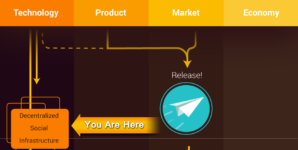As the Qrator launch approaches, it’s time to write more about its advantages and the way it could revolutionize the world.
The show business is one of the highest-earning industries in the world. The music industry alone earned stunning $15 billion last year. Digital sales (music streams and track downloads) now contribute 45 percent of the total worldwide industry revenue. While the digital products share continues to grow from year to year, the artists remain severely underpaid.
The average Youtuber makes between $800 and $1000 per 1 million views. On other platforms, such as Pandora, the payments go as low as $90 per 1 million views. And sometimes that money has to be split with the publishers or the network artist is a part of. This often means that the earnings from these platforms are not even enough to cover the costs of creating the content itself.
Instead of encouragement, content creators are usually left with nothing but the personal satisfaction of showing the piece to the world.
But it doesn’t have to be that way. The Qrator was created to motivate the people who provide valuable content for their audience.
What is Qrator and how it works?
Qrator acts as a browser extension that allows users to Amplify content they like (or expect to go viral) using AMP – Synereo’s cryptocurrency. The user gets a unique link from Qrator which can be used for sharing the content on social media and getting sort of “dividends” in AMP. The more AMP user invests in the content and the more views it generates through the given link – the higher the earnings.
The majority of the AMP “invested” in the content by curators will be passed to the original content creator. That way, both the curators and content creators can make a living from their work.
Now, the artists can get another source of income without any additional effort. Instead of getting pennies from Youtube, original content creators can earn a decent profit from shares on social media and curators’ investments.
It’s even possible to offer a reward for those who can successfully distribute the content allowing creators to reach the new audience, be discovered by other influential people from the industry and subsequently increase their earnings.
Qrator also offers a distributed content network, which should serve as a way to completely bypass the platforms such as YouTube and enable the content creators to remain complete owners of the content and make decisions on their own. This could result in direct collaboration between the companies in need of advertising and the artists. By cutting out the middleman, content owners could almost double the profits.
Conclusion
An exciting road lies ahead of us. Imagine the world where the little man gets to make the decisions and collect the profits. With Qrator, that could become a reality, and we’re looking forward to it.
You can learn more about the project here.








